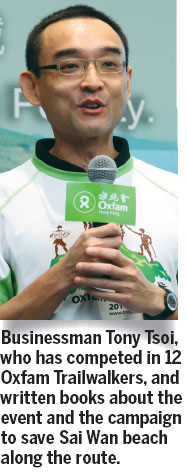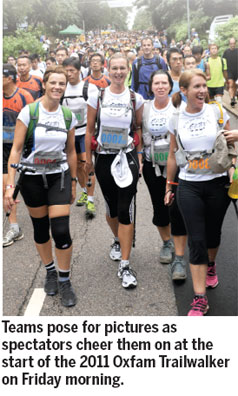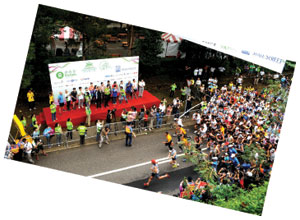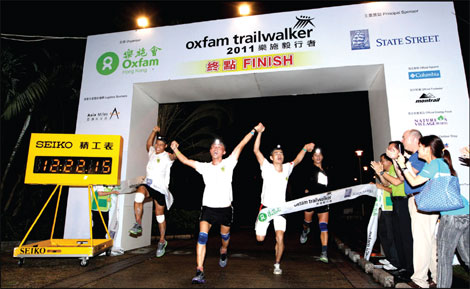Walk on the wild side
Updated: 2011-11-23 07:28
By Simon Parry(HK Edition)
|
|||||||||

A record field of 4,800 people joined the Oxfam Trailwalker on Friday as the event, which started as a military training exercise, celebrated its 30th anniversary. More than just an extraordinary physical challenge, the grueling 100 km race has evolved into a showcase for Hong Kong's natural beauty and a focal point for its preservation, reports Simon Parry.
When a billionaire businessman tried to turn a beautiful but remote Hong Kong beach into a private resort last summer, he must have anticipated a certain number of objections from hikers, surfers and environmentalists.
What Simon Ho may not have expected, however, was the tidal wave of outrage that saw tens of thousands of people sign up to a Facebook campaign against the proposal to build the resort in Tai Long Sai Wan in Sai Kung Country Park, in an outpouring that killed the project stone dead.
It wasn't just green groups who protested. It was people from the whole spectrum of society, according to Tony Tsoi, who wrote a book about the campaign. "Basically a group of people came together from different walks of life for a single cause - to protect Sai Wan," he said.
Like many others, Tsoi - a businessman living on Hong Kong Island - only knew about the beach and joined the campaign for one reason: Because of the Oxfam Trailwalker, which he has taken part in every year for the past 12 years and which crosses Sai Wan in one of its most sublime and spectacular sections.
|
Elite teams burst through the tape at the start of the 2011 Oxfam Trailwalker on Friday. Photos by Red Door News, Hong Kong |
"As soon as I saw the news report about the development I knew it was part of the trail," he said. "Two days later, I went out and trained on that route. I saw what was happening and I was furious. Later I decided to write a book about the campaign to stop it."
"It was because of the Trailwalker that I got involved. I thought 'Why are these guys doing this?' I think a lot of the reaction was down to the Trailwalker because it is a part of the route."
By taking thousands of people a year to Sai Wan beach, the Oxfam Trailwalker helped created a sense of affinity that ultimately saved it from development, he believes. "If you want to protect something first you have to use it," said Tsoi, 47. "If no one uses it, then your excuses are quite thin."
The saving of Sai Wan is a potent example of how the 100 km Oxfam Trailwalker, which celebrated its 30th anniversary thought the weekend, is much more than a mere test of stamina for the thousands of people who tackle it each year: It is also a focal point for the preservation of Hong Kong's countryside and coastline.
With a debate currently raging over whether indigenous villagers should be allowed to build more and taller homes in previously development-free parts of Hong Kong's country parks, the role of the Trailwalker can be increasingly vital in the years ahead.
Weaving its way through some of the most dramatic, challenging and unpopulated parts of the territory, the Trailwalker takes participants, who must complete each section in teams of four, along the MacLehose Trail - named after former governor and keen hiker Crawford Murray MacLehose.
It was mapped out by Gurkha soldiers, including Danny Thapa, now 58 and still living in Hong Kong. Speaking as this year's anniversary race began, he told the China Daily he had no idea that the route he and his colleagues laid out in the late 1970s would become such a phenomenon three decades on.
"We didn't do it as an actual trail walk at first - it was done for a military exercise," he said. "Then our regiment thought about doing some fundraising in 1981. Different regiments took part and we raised some funds which went to the needy back home in Nepal. It provided schools and libraries and clean water projects in remote areas.
"I am so absolutely chaffed to see it grow in such an enormous way. Over the years Oxfam has done such fabulous work and put so much effort into it and to get people from Hong Kong - and overseas people - involved. It's just grown and grown."
Thapa said he believed the Trailwalker had helped increase Hong Kong people's appreciation of their countryside. "The coastline and the New Territories are so beautiful and people actually sometimes don't realize how much natural beauty there is there," he said.
"If people took the trouble to go out once or twice a season they would see what richness they are standing on and they should treasure that."

Before he picked up the hiking bug that led him to the starting line of his first Oxfam Trailwalker 12 years ago, businessman Tsoi admitted he was among the many Hong Kong people who rarely, if ever, set foot in the countryside.
"I was like any office worker in Hong Kong," he said. "I was very busy and I did not join any organized sports. You travel and you are busy and you tend to engage in individual activities, like going to the gym. That is what most office workers do.
"Then there was an epiphany for me. One day - a gorgeous day like today - it was a Sunday and I had nowhere to go and I was running on a treadmill in a gym. I suddenly thought how pathetic I was. It was such a gorgeous day why was I indoors running on a machine?
"After that, I asked around and found some friends who enjoyed hiking, and I decided to join them. Before that, I hadn't really been out to the New Territories at all.
"I have been doing it for more than 10 years and the positive thing is that more and more Hong Kong people are hiking now. I think SARS in 2003 was a factor. The good thing is you see a lot of adults bringing their children out into the countryside."
As well as writing a book on the campaign to save Sai Wan, Tsoi has also written a book on the Oxfam Trailwalker itself, which included interviews with what he calls "ordinary walkers" and the band of volunteers who since pre-handover days have manned checkpoints along the route and still do so today, despite their dwindling numbers.
His book goes some way to unraveling the phenomenon of the Oxfam Trailwalker's success in a city that is not traditionally known for its love of either the countryside or vigorous exercise. "There's no one magic formula but if I have to pinpoint one reason, it is the rule that you must complete it in a group of four people - I think this is the magic," he said.
"You have to pass each checkpoint together. You may absolutely hate one of your teammates, but when you pass through that checkpoint, you have to wait for him or her. It is forced teamwork.
"Let's face it, we are on our own most of the time, but this is one time you have to learn to live and work with a group of people. You have to - not just in the race but in training as well. To do well, you have to plan. It is not a spontaneous sport.
"It's not an event where you can think you are fit and have no training and get three drinking buddies to join you at the starting point on the day - there's no way you can do that. You have to plan for it. It's tough."
Oxfam Trailwalker fundraising manager Brenda Wong said it is the sheer physical difficulty of reaching the finishing line that draws people. "I think the core of the whole thing is the challenging nature of the event. It's 100 km, taking in 20 mountains and walking day and night," she said.
"It attracts unusual people - extraordinary people I would say, be it the walkers, their support teams or our volunteers. It is the nature of the event which attracts special people and these people they contribute their talents efforts time tears - everything - to make it successful over the years."

Wong, who worked for the Hong Kong Tourism Board before joining Oxfam to promote the Trailwalker in 1997, said: "Every year, I keep bumping into new walkers who say they have been in Hong Kong for 10 years or more and never knew there were places as beautiful as there are along the Trailwalker route.
"Coming from the Hong Kong Tourism Board I feel a little ashamed, because part of the Hong Kong government's work should be to promote the beautiful countryside of Hong Kong. It is so accessible and so beautiful. I would say it offers a better experience than just shopping and eating."
Asked if she thought the government was doing enough to promote the city's countryside, Wong said: "I personally don't think so, because when I was at the Hong Kong Tourism Board, I am supposed to take charge of green tourism, but I didn't see we made much progress, because I think fundamentally the Hong Kong government doesn't see it as necessary.
"The way they see it, we already have sufficient numbers of tourists coming to buy things and to eat, and why bother to bring people to the remote countryside? That's my personal feeling."
Despite the lack of promotion, visitors were discovering the countryside for themselves, Wong said. "We keep meeting more and more people from the mainland along the route," she said. "When we speak to them it is amazing how much they know about our countryside but we just don't know how they managed to get all the information.
"We think they are middle-to-high-income class people who think Hong Kong offers a beautiful and safe countryside."
The event has also done much to take Hong Kong people out of their high-rises and into the countryside, she argued. "The majority of Hong Kong people don't have enough time to appreciate the countryside and it is not their priority," she said.
"I keep telling my family and friends that if they bring their children to the countryside at an early age, they will enjoy life much earlier and more and they will have a better character and personality when they grow up."
The Oxfam Trailwalker has already been exported from Hong Kong to 15 cities worldwide in countries including England, Spain, Australia, New Zealand, Japan, India, Ireland, Canada, Germany, Belgium and Holland. Now there are plans to expand it elsewhere in the region.
"We are looking at developing a Trailwalker in Taiwan or in the further future maybe in the mainland," said Wong. "To run an event like Trailwalker, we need a lot of support from the government before we begin the event."
"We are hoping the participation of the People's Liberation Army will help us promote the event in the mainland and among government officials. That is our future plan."
One of two teams from the Hong Kong Garrison of the People's Liberation Army completed the 100 km route on Friday evening with a time of 12 hours and 22 minutes, bagging championship for a third consecutive year for the garrison. They were three minutes ahead of the second-placed North Face Flight team.
Oxfam has already explored the possibility of Trailwalker events in Guangzhou, Guizhou and Beijing, where the walk might take in stretches of the Great Wall.
Asked how soon she expected to see a Trailwalker on the mainland, Wong said: "I always say best before my retirement and I am looking forward to an early retirement. I am now 46 and I hope it can be before I turn 50."
In Hong Kong, meanwhile, Tsoi believes the Trailwalker will continue to play a key role in preserving precious countryside and coastal areas like Sai Wan and keeping developers at bay. "I think it will help to make them less likely to try to develop in these areas," he said.
"These tycoons have many ways to make money. Why bother taking on these groups of activists? I think they will think twice in future. We won't stop them altogether but we will make them think there must be easier ways for them to make money."
Thapa, meanwhile, is keen to ensure that money from the event continues to support development in his native Nepal and has been given assurances by Oxfam that some of the tens of millions raised every year do still help the needy in the Himalayan nation.
The retired Gurkha sat out this year's event and hasn't walked the route with a team since his third and final Trailwalker in 1995. But Thapa - whose home village in Nepal used to be seven days' walk from the nearest main road - is determined to give it one last try.
"I'd love to take part again once year soon," he said. "I am sure I can still do it in under 48 hours, and my ambition is to do one final Trailwalker before I hang up my boots."
|
The winning team from the Hong Kong Garrison of the People's Liberation Army cross the finishing line of the Oxfam Trailwalker on Friday evening. |
(HK Edition 11/23/2011 page4)

